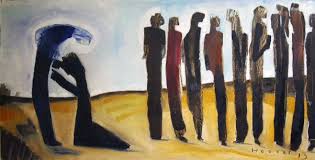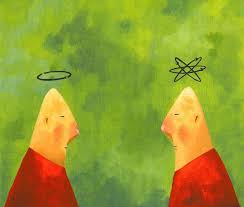Anxiety – If You Were Not Afraid
“What would your life be like if you were not afraid?”
Recently, I was reading in a magazine that when you walk into the building that houses Facebook, the very first thing that catches your eye is an enormous mural. On it, written in huge letters, is this very same question: What Would Your Life Be Like If You Were Not Afraid?
Similarly, in the Gospel of Luke, among the very first words out of the mouth of the angel addressing Mary are these: “Do not be afraid.” Later in that same gospel, Jesus speaks these soothing, consoling words to his followers: “Don’t fuss about what’s on the table at mealtimes or if the clothes in your closet are in fashion. There is far more to your inner life than the food you put in your stomach, more to your outer appearance than the clothes you hang on your body. Look at the ravens, free and unfettered, not tied down to a job description, carefree in the care of God. And you count far more …. What I’m trying to do here is get you to relax, not be so preoccupied with getting so you can respond to God’s giving…. Steep yourself in God-reality, God-initiative, God-provisions. You’ll find all your everday human concerns will be met. Do not be afraid … You’re my dearest friends!” (Lk, 12, 22-23; translation by The Bible In Contemporary Language, The Message).
“Do not be afraid. You’re my dearest friends.”
A case could be made that this is the quintessential message of the entire New Testament.
Why would that be?
Because if you stop to think about it, fear is what undergirds all real sin – the fear that I’m not going to get enough of whatever it is I want: enough love, enough power, enough money, enough possessions, enough attention, fame, glory, adulation. And so, out of fear, I take, I grab, I seize.
Go back for a moment to that marvelous story of the garden of Eden. Adam and Eve are surrounded by abundance. They’ve got it all. Everything’s in order. Shalom reigns supreme.
Then comes the snake’s whisper: You can have more. You can be like God and have infinite power and glory.
And so out of fear that they’re missing out, out of fear that they’re not getting the More, they grab, they take, they seize what isn’t theirs.
Do not be afraid.
The Bible seems to love these four words. It seems to understand that somehow fear is at the bottom of all sin and depravity. In fact, a biblical scholar tells us that these very words are used 365 times throughout Sacred Scripture – one for each day!
And yet we – you and I – clearly are afraid. More than “worried,” more even than “afraid,” many people live lives of outright terror – a kind of terror that most us could not even imagine.
In fact, in my more than twenty-five years working as a psychologist, I would submit that anxiety, worry, fear, terror is even more common and more debilitating than depression – although the two often go together and become almost indistinguishable.
If you find this a little far-fetched, listen to these descriptions that people who suffer from severe anxiety give:
“Anxiety is love’s greatest killer. It makes others feel as you might when a drowning man holds on to you. You want to save him, but you know he will strangle you with his panic.” Anais Kim
“Worrying is carrying tomorrow’s load with today’s strength – carrying two days at once. It is moving into tomorrow ahead of time. Worrying doesn’t empty tomorrow of its sorrow, it empties today of its strength.” Carrie ten Boom
“Anxiety is the dizziness of freedom.” Soren Kierkagaard
I would put it this way: fear is life’s number one hostage taker.
But these are only descriptions. Here are some facts based on the list of Stress/Anxiety statistics from a website called Statistic Brain, the American Psychological Association’s latest data:
Anxiety disorders: the most common mental illness in the USA
They affect 40 million adults age 18 and older
They are highly treatable, yet only 1/3 of those suffering receive treatment
They develop from a complex set of risk factors, including genetics, brain chemistry, personality and life events
Nearly one-half of those diagnosed with depression are also diagnosed with an anxiety disorder
In his book, Worry, the Harvard psychiatrist Edward Hallowell begins by making an important distinction between neurotic fear and “the ordinary worry of everyday life.” The latter serves as a useful built-in alarm system that keeps us from doing dangerous things like texting while we drive, preparing adequately for a presentation, getting to work on time, and making sure my kids are properly dressed. This kind of worry he calls “worrying well.”
Anxiety, worry, stress becomes a pathological problem when our built-in alarm system won’t shut off, when “it won’t silence itself.” Then, according to Hallowell, “it becomes a relentless scavenger, roaming the corners of your mind, feeding on anything, never leaving you alone.” This he calls “toxic worry” or “neurotic worry.” Toxic anxiety, then, is caused by a malfunction of the brain that involves genetics, personality and inordinate life events. The brain’s inner barometer that measures sensitivity to fear is set too high. The brain then over-reacts, over-responds.
Here is the way Dr. Hallowell describes “toxic” or “neurotic” fear:
“Toxic worry is a disease of the imagination. It is insidious and invisible, like a virus. It sets upon you unwanted and unbidden, subtly stealing its way into your consciousness until it dominates your life. As worry infiltrates your mind, it diminishes your ability to enjoy your family, your friends, your physical being, and your achievements because you live in fear of what might go wrong. It undermines your ability to work, to love, and to play.” (Worry, p. xiii)
According to the most recent Diagnostic and Statistical Manual (DSM-V), there are numerous examples that are listed as anxiety disorders. Six of these are most common. These are listed on an accompanying document entitled Anxiety Disorders, along with what can be done to help people who are struggling with them. I refer you to that document for further discussion of each of the following anxiety disorders: Generalized Anxiety Disorder, Phobias, Obsessive-Compulsive Disorder, Post-Traumatic Stress, Social Phobia, and Panic Attacks.
What would your life be like if you were not afraid?






